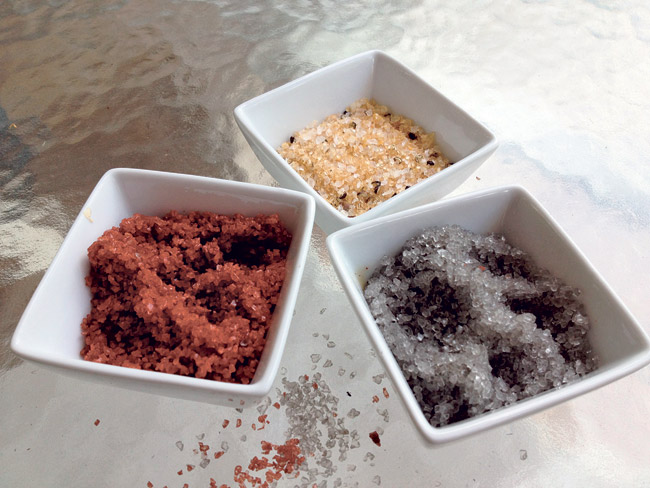Exploring A Whole New World Of Salt

(Clockwise, from left) alaea salt, herb-infused coarse sea salt and kiawe-smoked salt | Jo McGarry photo
If you’re still reaching for the carton of coarse kosher or sprinkling iodized sodium chloride into your pasta pot, you might want to expand your culinary horizons and explore the wonderful word of salt. The world’s most ancient condiment also is one of the most exciting.
I’m not sure there’s a pantry staple that has gone through such a dramatic reinvention as salt. Ten years ago, if you used kosher salt in cooking and had French Fleur de Sel on the table, you were most likely in the minority.
Today, there are dozens of types of salt that include everything from fine table salt to coarse ocean salt, smoked sea salt, red salt, black salt and finishing salts, aka fancy salts, – a blend of coarse sea salts infused with herbs and other seasoning. And lucky us, because in Hawaii we have an increasing number of companies producing flavored salts, coarse salts and Pacific sea salts that add dramatic flavor and texture wherever you use them.
On Maui, celebrity chef Bev Gannon, one of the original Hawaii Regional Cuisine chefs, uses Sea Salts of Hawaii in her kitchens at Hali’imaile, Joe’s and Gannon’s. She is one of dozens of chefs in Hawaii who can talk – and taste – salt for hours.
“I buy salt in every country I travel to,” she says, “and when we come home, my husband and I have salt tastings.”
All you need, she says, is some really good French bread and some unsalted butter. “A salt tasting can be really great fun,” she says.
And you don’t need a lot of food. “The other night we went to a friend’s house and had hardboiled eggs, some tomatoes, some cheese, roasted beets, good bread – and it was amazing how the different salts changed the flavor of the food,” says Gannon.
There are many companies producing flavored salts in Hawaii, so be prepared to be amazed at the variety.
Sea Salts of Hawaii’s herb-infused salts add intense flavor – so much so, you can turn a simple tomato salad into something extraordinary by sprinkling some red clay, Maui onion or bamboo extract. At Salty Wahine on Kauai, one of the most popular salts is a kiawe-smoked blend of Pacific sea salt and kiawe wood. Rub it on steak or salmon and the flavors are infused into the meat.
Gannon is so inspired by the salts of Hawaii that she’s working on a summer menu that includes new dishes in which salt is the star.
“We’re adding a goat cheese pana cotta at Hali’imaile that is topped with Maui onion sea salt as one new dish,” she reveals.
And these coarse sea salts don’t just taste great (try adding them to chocolate chip cookie dough if you don’t believe it). Research shows that they’re much better for us than the chemically cleaned and processed table salt most of us are exposed to daily.
The best way to use most flavored salts is at the end of cooking. Or, in the case of grilled meats and fish, just before you put them to the flame, because while salt is a powerful seasoning agent, it will draw moisture away from meat the longer it’s left to sit.
There’s a huge variety of locally produced sea salts available at Island Olive Oil at Ward Centers, specialty food stores including R. Field Wine Company at Foodland and at other local supermarkets.
I asked Gannon what is her favorite way to enjoy Hawaii’s sea salt, and she answered immediately, “On the rim of a Bloody Mary, Maui onion flavor. So good!”
Happy Eating!





